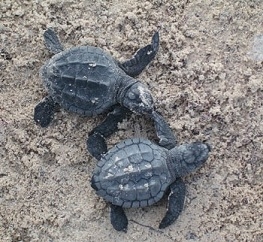Atlantic Ridley Sea Turtle (Lepidichelys kempi)
Description: Kemp's ridley is the smallest of all sea turtle species, reaching maturity at 20 to 28 inch carapace length and weighing only 79 to 99 lbs. Typical of sea turtles, it has a dorsoventrally depressed body with specially adapted flipper-like front limbs and a beak. Kemp's ridley turtle adults reach a maximum of 30 inches in carapace length and weighing a maximum of 110 lbs. The adult's oval carapace is almost as wide as it is long and is usually olive-gray in color. The carapace has five pairs of costal scutes. In each bridge adjoining the plastron to the carapace are four inframarginal scutes, each of which is perforated by a pore. The head has two pairs of prefrontal scales.
These turtles change color as they mature. As hatchlings, they are almost entirely a dark purple on both sides, but mature adults have a yellow-green or white plastron and a grey-green carapace.
Kemp's ridley has a triangular-shaped head with a somewhat hooked beak with large crushing surfaces. The skull is similar to that of the olive ridley. Unlike other sea turtles, the surface on the squamosal bone where the jaw opening muscles originate, faces to the side rather than to the back. They are the only sea turtles that nest during the day.
Habitat: Lepidochelys kempii mainly stays near shallow coastal regions characterized by bays and lagoons. These turtles prefer waters that have sandy or muddy bottoms, but also may take to the open seas. At sea, this species has the ability to dive to great depths.
Range: The distribution of L. kempii is somewhat usual compared to most reptiles, varying significantly among adults and juveniles, as well as males and females. Adults primarily live in the Gulf of Mexico, where they forage in the relatively shallow waters of the continental shelf (up to 409 m deep, but typically 165 feet or less), with females ranging from the southern coast of the Florida Peninsula to the northern coast of the Yucatán Peninsula, while males have a tendency to remain closer to the nesting beaches in the Western Gulf waters of Texas (USA), Tamaulipas, and Veracruz (Mexico). Adults of L. kempii are rarely found outside of the Gulf of Mexico and only 2-4% from the Atlantic are adults.
Juveniles and subadults, in contrast, regularly migrate into the Atlantic Ocean and occupy the coastal waters of the continental shelf of North America from southern Florida to Cape Cod, Massachusetts, and occasionally northward. Accidental and vagrant records are known with some regularity from throughout the northern Atlantic Ocean and Mediterranean Sea, where the Gulf Stream is believed to play a significant role in their dispersal. Confirmed records from Newfoundland to Venezuela in the west; to Ireland, the Netherlands, Malta in the Mediterranean, and numerous localities in between are known in the east, although more than 95% of these involve juveniles or subadults. Several reports from the African coast from Morocco to Cameroon involve unverified specimens and may include misidentified L. olivacea.
Diet: Kemp's ridley turtle feeds on mollusks, crustaceans, jellyfish, fish, algae or seaweed, and sea urchins. Juveniles primarily feed on crabs.
Reproduction: This is the only species that nests primarily during the day. The nesting season for these turtles is April to August. They nest mostly (95%) on a 16-mile beach in the Mexican state of Tamaulipas and on Padre Island in the US state of Texas, and elsewhere on the Gulf Coast. They mate offshore. Gravid females land in groups on beaches in arribadas or mass nesting. They prefer areas with dunes, or secondarily, swamps. The estimated number of nesting females in 1947 was 89,000, but shrank to an estimated 7,702 by 1985. Females nest one to four times during a season, keeping 10 to 20 days between nestings. Incubation takes 6-8 weeks. Around 100 eggs are in a clutch. The hatchlings' sex is decided by the temperature in the area during incubation. If the temperature is below 85.1 ℉, the offspring will be mainly male.
Status: Lepidochelys kempii is currently listed as endangered by the United States Fish and Wildlife Service and IUCN.
»» Kingdom: Animalia - Animals
»» Phylum: Chordata - Chordates
»» Subphylum: Vertebrata - Vertebrates
»» Class: Reptilia - Reptiles
»» Order: Testudines - Turtles & Tortoises
»» Family: Cheloniidae - Sea Turtles
»» Genus: Lepidichelys
»» Species: Lepidichelys kempi - Atlantic Ridley Sea Turtle
»» Subspecies: None
This article uses material from the Wikipedia article "Kemp's Ridley Sea Turtle", which is released under the Creative Commons Attribution-Share-Alike License 3.0. Content may have been omitted from the original, but no content has been changed or extended.
|








